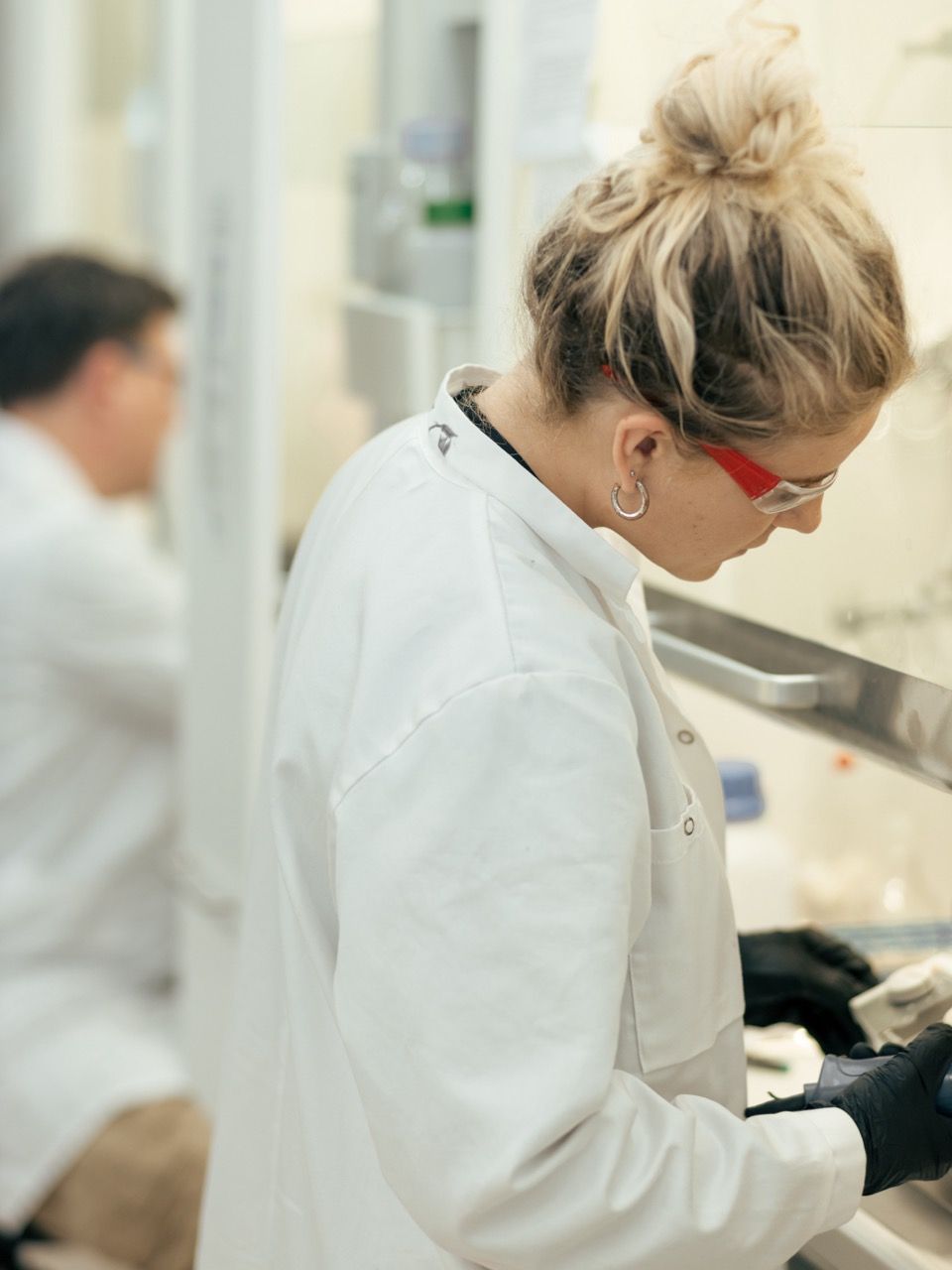Bringing Hope to Patients with Untreatable Lung Disease
Oxcia is helping patients battle Idiopathic Pulmonary Fibrosis (IPF) in this new project supported by the EIC called TOPFIBRO.

TOPFIBRO project and goals
In the TOPFIBRO (Targeting OGG1 in Idiopathic Pulmonary Fibrosis) program supported by EIC Transition grant the overall aim is to complete the pre-clinical development of the drug candidate OXC-201 as well as prepare and initiate the first-in-human studies investigating safety of the novel IPF treatment in human healthy volunteers. The goal of Oxcia’s research is to target the underlying inflammation and fibrosis in IPF to stop disease progression, protect and repair the lung tissue, improve lung function and halt the disease.
Involvement of patient organisations, physicians and Key Opinion leaders is part of the plan to secure their input into the project development. Furthermore, Oxcia has frequent contacts with Pharma and investors to understand their requirements.
IPF as a disease
Idiopathic Pulmonary Fibrosis (IPF) is a serious progressive lung disease that severely affects physical well-being and the condition develops when lung tissue becomes thick and stiff. It is characterized by a high degree of illness and mortality. Over time permanent scarring in the lung, called fibrosis, happens and this makes it difficult to breathe. Besides shortness of breath that becomes worse over time, additional symptoms can be a dry cough that is not improving, achy joints and muscles, feeling tired/weak and slowly losing weight. Common complications of IPF are pulmonary hypertension and respiratory failure. This happens when the lungs cannot deliver enough oxygen to the rest of the body, including the brain.
The underlying cause of IPF is unknown, but risk factors are for instance male sex, aging, smoking, diabetes and a family history of IPF.
Today there is no cure for IPF. Average survival is only 3-5 years after diagnosis (Swedish Pulmonary Medicine Association 2019). There are two approved drugs on the market – pirfenidone (Esbriet) and nintedanib (Ofev). These treatments do not cure the disease or improve survival, only slow down the progression of IPF and help the lungs work better. They are limited by adverse effects and drug interactions. There are reports showing that > 40% of patients stop the treatment within the first year due to side-effects. Doctors are sometimes reluctant to initiate therapy due to the shortcomings of available therapy which in many markets are also very costly. Consequently, there is a large proportion of patients that receive suboptimal or no treatment. Thus, the medical need for new effective and well tolerated treatments are huge.
Oxcias solution – OXC-201
Oxcia is developing a novel solution, OXC-201, based on completely new science published in the prestigious scientific journal Science 2018 by Professor Helleday, academic collaborators and Oxcia team. The new findings demonstrate the role of the DNA repair enzyme OGG1 (8-oxo guanine DNA glycosylase) in gene transcription in inflammatory and fibrotic disease.
OXC-201 has the potential to be a ground-breaking novel approach for treatment of IPF), with potential to substantially improve and even halt inflammation and fibrosis.
OXC-201 is a small molecule inhibitor of OGG1. By targeting OGG1, OXC-201 inhibits binding of OGG1 to DNA and thereby the modulation of gene transcription. Multiple key molecular pathways associated with IPF are inhibited and onset of fibrosis and inflammation is blocked. OXC-201 has successfully demonstrated therapeutic effects in several disease models.
Results up to now
“We are very happy for the support from EIC which enables us to further develop OXC-201, a compound that we hope will improve quality of life and the prognosis for patients. Early data look very promising and we are looking forward to confirming these data in future trials.”

Christina Kalderén
Potential impact
OXC-201 has the potential to radically change and grow the IPF market. It has potential to halt the disease, improve lung function, improve survival and be safe and tolerable. It has potential to protect lung tissue and repair lung tissue, thereby possibly turning IPF to a chronic disease rather than a deadly disease.
The pre-clinical work in WP1 has during the first 12 months, delivered data that confirms the promising profile of OXC-201. Patent applications of the new chemical entity have been approved in Japan, China and US – countries with high number of IPF patients. The European application is under evaluation.
The IPF market has grown, there is a lot of untreated patients due to the limitations of current treatments and the interest from big pharma and biotech is currently very high with a lot of acquisition and licensing activities and high deal values.
The market research done in the program has confirmed that the two approved therapies for IPF have severe limitations and that the unmet medical need is enormous. Costs are also very high.
Lung transplantation improves survival but is open only to some patients. Selection of patients is based on certain criterias: high risk of death (>50 %) in the following two years without transplantation, reasonably good physical condition, high probability of survival 90 days after intervention (>80 %) and high probability of surviving five years after the transplant (>80 %). For example, patients > 65 or with severe morbidities are all excluded from the transplantation waiting lists
OXC-201 has potential to provide important economic and societal benefits.
The foremost effect of TOPFIBRO will be accelerating the development of an urgently needed treatment for IPF. IPF is considered a terminal diagnosis and low survival rate of 3-5 years post diagnosis. Shortness of breath and severe cough, further decrease quality of life and overall capabilities of the patient. OXC-201 would be the first potentially curative therapy for IPF, thereby significantly improving quality and length of life compared with current standard of care treatment. There will also be other positive impacts following the project, for patients in the selected additional indications and regarding employment when Oxcia significantly gears up resource wise for further clinical development. Inhibition of OGG1 is a novel ground-breaking approach for treatment of inflammatory and fibrotic diseases. Reported data and future research not only open up for potential new treatment of several indications with high unmet medical need, but also contribute to a better understanding of the pathology of inflammatory and fibrotic diseases by accumulating scientific knowledge
Oxcias goal is to demonstrate health economic value with OXC-201. Today the cost burden is very high both for Health payers and patients, who are today not always able to afford treatment. As OXC-201 significantly improves lung function and survival and has very good tolerability, quality of life will increase and mean higher Quality Associated Life Years (QALYs) compared to current standard of care.
TOPFIBRO Contacts
For further information please contact:
Christina Kalderén, Pre-clinical Director
Email: christina.kalderen@oxcia.com
Briefly about Oxcia
Oxcia AB conducts innovative research through its unique way of utilizing oxidative DNA damage and DNA Damage responses (1) and develops novel, safe and effective treatments for patients suffering from cancer, inflammation or fibrosis. Oxcia currently has two drug candidates, both with first-in-class potential. OXC-101 is in early clinical development for the treatment of solid and hematological cancers. OXC-201 is being developed as a treatment for inflammation and fibrosis-related diseases and is in the preclinical phase.
More information about Oxcia is available at www.oxcia.com
(Note (1): DNA Damage Response, DDR – the body’s processes to in various ways repair the damage that occurs to DNA)